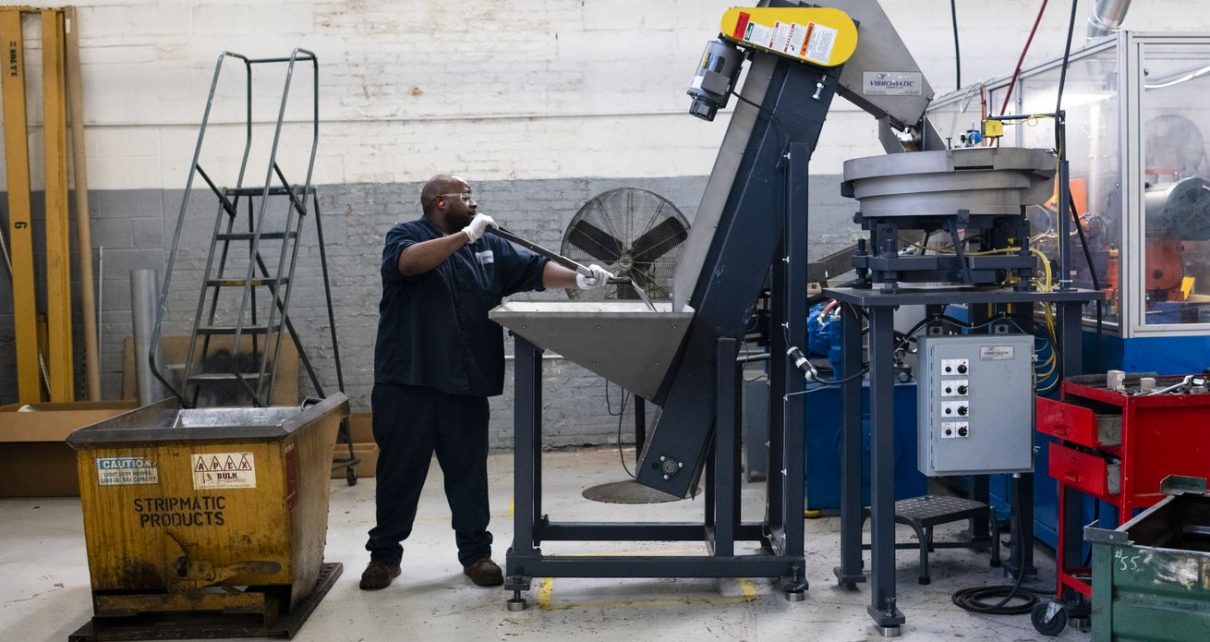
Biden’s domestic policy is also foreign policy.
The dire warning implicit in President Joe Biden’s more than $2 trillion American Jobs Plan — which promises to rebuild American infrastructure, create union jobs, and jump-start manufacturing — is that if it fails to become law, China will outcompete the United States for decades to come.
Biden has been saying that China is “eating our lunch” for months, promising his plan would “put us in a position to win the global competition with China in the upcoming years.”
“This is not part of my speech,” he said during April 7 remarks to sell his plan, “but I promise you, you’re all going to be reporting over the next six to eight months how China and the rest of the world is racing ahead of us in the investments they have in the future, attempting to own the future.”
Mentioning China so often when talking about a domestic infrastructure plan might seem odd. But it makes sense if you realize that Biden’s signature domestic economic policy plan is also a critical element of a broader foreign policy strategy to thwart China’s growing power and global influence.
“When [Biden’s] thinking about the infrastructure investments necessary, a lot of it is in contraposition to what he is seeing China doing in terms of strategic investments,” National Economic Council director Brian Deese recently told the New York Times’s Ezra Klein.
The idea is that making America more economically competitive by improving domestic infrastructure and investing in new and emerging technologies, especially clean energy technology, is the best way the US can challenge China for supremacy on the world stage — even more so than through military might or by trying to win the “war of ideas” against China’s authoritarianism.
Competing with China is fundamental to Biden’s presidency and goes hand in hand with his promise to bring middle-class jobs back to the United States. Biden envisions those jobs in manufacturing electric vehicles in Detroit, and long-duration energy storage that can store the clean energy generated from wind and solar, among other jobs in the clean energy economy.
Yet the constant framing of China as America’s greatest competitor, if not outright foe, is not without its hazards.
Anti-China sentiment and hate crimes against Asian Americans are on the rise in the United States, in large part due to former President Donald Trump’s aggressive anti-China rhetoric and posture, and in particular his insistence on using racist and xenophobic language to blame China for the Covid-19 pandemic.
Though Biden and Trump may agree on the goal of making America more competitive with — and stronger than — China, Biden seems to recognize the need to be more careful in his messaging. The president has strongly condemned hate crimes against Asian Americans, calling such violence “un-American.”
Asian Americans have “been attacked, blamed, scapegoated, and harassed,” Biden said in a White House address on the one-year anniversary of the coronavirus being declared a pandemic by the World Health Organization. “They’ve been verbally assaulted, physically assaulted, killed. … It’s wrong. It’s un-American, and it must stop.”
/cdn.vox-cdn.com/uploads/chorus_asset/file/22457697/1232397238.jpg) Xinhua/Li Jianguo via Getty Images
Xinhua/Li Jianguo via Getty ImagesStill, hammering home the critical importance of competing against China without painting the country as a threat could be a tricky line for him to walk.
The coming weeks will determine whether Biden’s big domestic and foreign policy gamble pays off. If it doesn’t, Biden will have suffered a loss on two fronts.
China’s infrastructure spending vastly outmatches that of the United States
Biden’s refrain about China “eating America’s lunch” has a lot to do with just how much China has spent in recent years to improve its domestic infrastructure to become more competitive in the world economy.
China’s years-long investment in domestic infrastructure has produced a sprawling network of high-speed train lines, at least 1 million bridges, and entire cities springing up — sometimes without enough people to fill them.
China spends more than three times what the US does on infrastructure: about 8 percent of its gross domestic product (GDP), versus just 2.4 percent of GDP in the US, according to a 2017 report by the consulting firm Deloitte.
In 2020, China’s dollar investment in infrastructure, buildings, and other projects was about $8 trillion US, according to China’s National Bureau of Statistics. Meanwhile, the US federal government spent $63 billion directly on infrastructure projects in 2020, granting an additional $83 billion in infrastructure funding to states — a total of $146 billion. In other words, the US invested a small fraction of China’s total spending for the year.
Biden’s $2.25 trillion American Jobs Plan will amount to about 1 percent of America’s GDP per year over about eight years, according to a Biden administration official. But even with that factored in, US spending pales in comparison to China’s.
“Right now, China doesn’t need to invest that much more; it has a brand new infrastructure that’s already been built,” Kelly Sims Gallagher, a professor of energy and environmental policy at Tufts University, who served as a senior China adviser in the Obama administration’s Special Envoy for Climate Change office, told Vox.
In comparison, she said, “we need to rebuild the original infrastructure, which is old and outdated, we need to climate-proof that infrastructure, and we need to be competing with China internationally for those global markets.”
Biden’s plan is a lot more than the $621 billion in spending dedicated to rebuilding what is traditionally considered “infrastructure”: the nation’s roads, bridges, ports, and rail systems. It also contains $300 billion to bolster manufacturing, $213 billion for affordable housing, and a collective $380 billion for research and development, modernizing America’s electricity grid, and installing high-speed broadband around the country. The plan also includes $400 billion for home- and community-based health and elder care.
Biden administration officials have been explicit that they see this plan as a major driver of job growth in the United States across multiple sectors, including construction, manufacturing, and energy. They frequently tout the sheer size of the plan, with Biden calling it the “single largest investment in American jobs since World War II.” And with a $2 trillion federal investment, the Biden administration is betting the private sector will spur even more job growth.
/cdn.vox-cdn.com/uploads/chorus_asset/file/22457701/1307561082.jpg) Zhang Bin/China News Service via Getty Images
Zhang Bin/China News Service via Getty Images“Part of the economic logic of this plan is that this is not just about infrastructure, but it’s about creating more jobs and more industrial strength in the United States,” a Biden administration official told reporters. “When you make these infrastructure investments and couple it with the president’s commitment to buy American, you’re pulling forward and creating demand that will help accelerate new industries in the US.”
What the US lacks in manufacturing capacity, it can make up for in cutting edge research and development, experts told Vox. Especially when it comes to clean energy technologies that will power the world for years to come, the Biden administration sees an opening.
“The US needs to think strategically about what is our role in developing … essentially the next generation of these technologies, because we’re never going to compete with China on pure manufacturing scale,” Joanna Lewis, director of the science, technology and international affairs program at Georgetown University and an expert on US-China relations, told Vox.
Biden’s China push differs from Obama’s and Trump’s
Engagement with China, meaning consistent and significant dialogue on areas of mutual interest, has defined Washington-Beijing relations since the Nixon era. Presidents from both parties wanted China to become a “responsible stakeholder,” a wonderfully wonky Washington term that mostly means they hoped Beijing would abide by global, cooperative rules even as it gained immense power. In effect, they wanted to make China act more like America.
That bipartisan consensus started to fall apart in President Barack Obama’s second term as China relentlessly began cyber espionage and hacks of the US government. But more importantly, Obama used beating China economically as his main selling point for the Trans-Pacific Partnership, a 12-nation free trade deal representing roughly 40 percent of the world’s GDP.
The objective of the deal was to partner with other countries in the region to reduce China’s influence. But that deal became mired in domestic politics: Unions, some progressives, and some on the right opposed it. The deal eventually collapsed under congressional pressure. Neither Democratic presidential challenger Hillary Clinton nor Republican nominee Donald Trump engaged with it during the campaign.
As president, Trump took it up a notch and pushed an approach that viewed China more as an enemy than a competitor.
Instead of working with allies to box China in, the US would make a series of moves to derail Beijing’s economic future. “Trump looked to reduce China’s ability to compete, whether it was in cyber, tech, or economics,” said John Costello, who served as a top Commerce Department official for intelligence and security in the Trump administration.
He launched a multibillion-dollar trade war; aimed to downgrade China’s prevalence in the supply chains of many industries, like putting pressure on Apple to move its products from factories in China to factories in Vietnam; and restricted the access of Chinese telecommunications companies such as Huawei and ZTE.
Trump’s plan was to wield America’s might to stymie China’s economic influence in the world. Only then, really, would the US have a shot at competing. However, studies showed that the trade war he launched hurt America’s ability to get protective equipment during the coronavirus pandemic, the manufacturing job losses hurt primarily people of color, and the virus’s origination in Wuhan, China, fueled anti-Asian sentiment that persists to this day.
For Biden, neither the Obama nor the Trump approach was quite right, and both failed in important ways. Obama’s international play fell flat but barely addressed economic needs at home. Trump aimed to revamp the domestic economy but did little to rally the world to counter Beijing comprehensively.
The new president’s approach, then, picks up where the last two strategies failed. “What the Biden administration is doing by broadening the way we discuss infrastructure is painting a picture of the future in which some of the constraints on our current infrastructure go away and new possibilities are realized,” said Anthony Foxx, the secretary of transportation from 2013 to 2017.
/cdn.vox-cdn.com/uploads/chorus_asset/file/22457705/1227942388.jpg) Kyle Mazza/Anadolu Agency via Getty Images
Kyle Mazza/Anadolu Agency via Getty ImagesBiden’s is essentially a two-pronged approach. The first is the domestic piece, which experts explain is about essentially beating China in a domestic race for new technologies. “It’s all about running faster,” said Costello, now a senior fellow at the Center for a New American Security think tank in Washington.
That’s going to be tough, as China remains determined to fund domestic projects and critical technologies, like artificial intelligence, that will keep the race with America close for years.
“China is ramping up AI investment, research, and entrepreneurship on a historic scale,” wrote Kai-Fu Lee, chair and CEO of the China-based technology firm Sinovation Ventures, in his 2018 book AI Superpowers: China, Silicon Valley, and the New World Order. Beijing “projected that by 2030, China would become the center of global innovation in artificial intelligence, leading in theory, technology, and application.”
But there’s a larger point to this domestic-focused plan. China’s government says that only an authoritarian nation can move at the speed required to “win the future.” Simply put, a strongman like Xi Jinping can dictate where and how much to invest in key industries faster than Biden can get Congress to approve proposals. With this infrastructure bill, Biden wants to prove democracies can still make big moves to outcompete the Chinas of the world.
“The autocrats are betting on democracy not being able to generate the kind of unity needed to make decisions to get in that race,” Biden said during an April 7 press conference. “We can’t afford to prove them right. We have to show the world — and, much more importantly, we have to show ourselves — that democracy works; that we can come together on the big things. It’s the United States of America for God’s sake.”
The second part is the global one plucked from the Obama playbook. But instead of an economic super-deal, Biden wants nations to work together to counter China’s aggressive behavior. That means banning Beijing’s telecommunications companies from their critical infrastructure, speaking out against China’s human rights abuses against Uyghur Muslims or Hong Kong, and pushing Xi to agree to bold climate change standards.
Despite its immense power, Biden’s thinking goes, the US can’t compel China to change in these areas unless and until America’s allies also stand against it. That, too, will be a difficult task. For example, the European Union and China are still finalizing a trade deal that would give Beijing preferential access to the EU’s market.
The Biden administration is against such a pact because, they argue, it sends China a signal that it can still make lucrative deals with democracies even as it erodes democracy back home.
The agreement, however, may not go through after sanctions the US and the EU placed on Chinese officials over mistreatment of the Uyghurs led Beijing to retaliate with sanctions of its own on EU officials. The continent’s leaders are still steaming over that move. “The prospects for … ratification will depend on how the situation evolves,” Valdis Dombrovskis, the EU’s trade commissioner, told the Financial Times in March.
Still, the key part of Biden’s China strategy is the domestic part, and the American Jobs Plan is the centerpiece of it. Now the president just has to convince Congress that it’s the right play.
Framing infrastructure as competing with China could get more GOP support
It’s still an open question whether there’s enough political will to pass Biden’s $2.25 trillion infrastructure and jobs plan. With Republicans wanting a smaller bill, some Democrats think the best way to get Biden’s plan through Congress is to hammer at the China competition angle with Republicans.
“The best way to enact a progressive agenda is to use China [as a] threat,” a Democratic congressional aide told Vox.
The theory that America is at its best when it’s united against a common adversary can motivate members of both parties, especially using the idea that the US will lose its competitive edge or cede ground to another country. Indeed, one of the few things both parties can agree on is the need to compete with China.
The Senate Foreign Relations Committee will soon formally introduce a bipartisan bill called the Strategic Competition Act, which focuses on countering China’s human rights abuses, prioritizing security assistance for the Indo-Pacific region, and combating intellectual property theft. And Senate Majority Leader Chuck Schumer has called on committees to work on the bipartisan Endless Frontiers Act, which focuses especially on strengthening the US semiconductor industry.
/cdn.vox-cdn.com/uploads/chorus_asset/file/22457714/1232422273.jpg) Sarah Silbiger/Getty Images
Sarah Silbiger/Getty Images“It seems to have some rhetorical benefit that other people have this great thing that we don’t have,” said Deborah Seligsohn, assistant professor of political science at Villanova University. “We somehow need to create a Sputnik era to have nice things,” she added, referring to decades of competition between the US and Soviet Russia over the countries’ dueling space programs.
At the same time, calling China a threat or adversary could have damaging — even dangerous — consequences in the United States. Amid a spike of hateful rhetoric and violence against Asian Americans across the country, Democrats say they recognize the need to make a big distinction between competing with the Chinese government to not cede economic ground, and portraying the Chinese people as enemies.
The US Senate is deliberating on a bill aimed at combating Asian American hate crimes that has bipartisan support, and Biden is ramping up his own outreach to the Congressional Asian Pacific American Caucus (CAPAC), meeting with them in mid-April.
“We need to stand by the AAPI [Asian American and Pacific Islander] community as a whole-of-government response with what we have to get done,” Biden told Asian American lawmakers at the CAPAC meeting.




